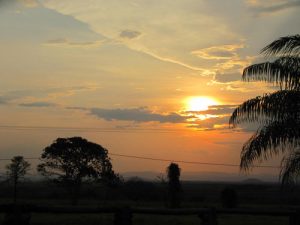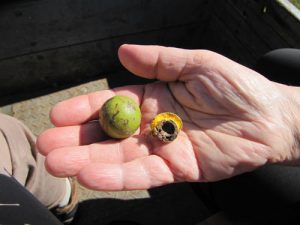 While attention is turned to the athletes competing at the Olympics in Brazil, bird people turn to ask what about birding in Brazil? When consulting the bird guides for Brazil, one learns quickly that the guides are regional. That is because a national guide would be too large for portability in the field because, frankly, there are too many species! In fact, Brazil boasts over 1,825 species with others being discovered or named continually. Brazil is considered one of the planet’s richest centers of biodiversity and represents 60% of the species found on the South American continent! With that comes the flip side — Brazil has the largest number of endemic (234) and threatened (116) species of any nation in the New World — that means it represents over one fourth of all of the species that are in trouble.
While attention is turned to the athletes competing at the Olympics in Brazil, bird people turn to ask what about birding in Brazil? When consulting the bird guides for Brazil, one learns quickly that the guides are regional. That is because a national guide would be too large for portability in the field because, frankly, there are too many species! In fact, Brazil boasts over 1,825 species with others being discovered or named continually. Brazil is considered one of the planet’s richest centers of biodiversity and represents 60% of the species found on the South American continent! With that comes the flip side — Brazil has the largest number of endemic (234) and threatened (116) species of any nation in the New World — that means it represents over one fourth of all of the species that are in trouble.
When you look at a map, you learn that Brazil is impressively large — it is the fifth largest nation on our fragile planet. It is larger than Western Europe. In fact, it has about the same area as the continental U.S.! Just like in the United States, travel distances are vast and need planning. One of the areas that is most frequented for ecotourism is the Pantanal, which I was able to visit. Most of the ecotourism in Brazil frequents that region, home to many parrot species from hyacinth macaws to the rare yellow-faced parrot.
 The Pantanal is a vast seasonally flooded wetland comprising about 80,000 square miles! The tropical rains begin in November and end around June. This results in the northern portion of the Pantanal flooding in January, while the southern portion receives the flood waters about two months later with flooding occurring about 2 times during the rainy season. The waters come from an even larger distinctively Brazilian tropical savanna habitat – the Cerrado. This one of the largest biomes of over 740,000 square miles. During the wet season, waters from the Cerrado pour into the large rivers of the Pantanal and there they temporarily flood the grasslands and gallery forests. This produces a large accumulation of water birds as well and contributes to the biodiversity of species. However, as the use of herbicides and fertilizers in the Cerrado increase, this produces a negative impact on the purity of the waters needed for plants and animals of the Pantanal.
The Pantanal is a vast seasonally flooded wetland comprising about 80,000 square miles! The tropical rains begin in November and end around June. This results in the northern portion of the Pantanal flooding in January, while the southern portion receives the flood waters about two months later with flooding occurring about 2 times during the rainy season. The waters come from an even larger distinctively Brazilian tropical savanna habitat – the Cerrado. This one of the largest biomes of over 740,000 square miles. During the wet season, waters from the Cerrado pour into the large rivers of the Pantanal and there they temporarily flood the grasslands and gallery forests. This produces a large accumulation of water birds as well and contributes to the biodiversity of species. However, as the use of herbicides and fertilizers in the Cerrado increase, this produces a negative impact on the purity of the waters needed for plants and animals of the Pantanal.
When the waters flood the land, the over 450 species of birds disperse but as the land dries out, they congregate to feed. This is particularly true of the water birds. One of the stars of the show is the Jabiru stork. Standing up to 55 inches tall, it has an enormous bill with a bare black head and neck with a red collar. They can be found in large flocks but more commonly in pairs. I must say that they are very impressive to see and listen to with their bill clacking, particularly when they guard their enormous nests.
The Pantanal is made up of mostly privately owned cattle ranches or fazendas that have been increasingly involved in ecotourism. There are a number of conservation-minded ranchers who are very involved in recovery of a number of species of wildlife, most notably the hyacinth macaw. At one time, the Pantanal boasted a large number of hyacinths but, like many species, there was a huge decline from trapping and other problems. In the 1980s, only about 1,500 individuals were left.
 Since the 1990s, the Hyacinth Macaw project or Projeto Arara Azul headed by Neiva Guedes has helped turn the corner for this magnificent macaw! In 15 years Neiva and her organization has tripled the numbers of Hyacinths in the Pantanal. The hyacinth eats the hard seeds in the center of the acuri and the bocaiuva palms. These are the only macaws with beaks massive enough to crack open the hard shells. In contrast, other species of parrots and macaws can only eat the outer husk. However, these palms need a certain type of grassland and those grasslands are dependent on cattle grazing on them to exist. Additionally, the cattle often eat these extremely hard fruits of the acuri and the bocaiuva palms while grazing, which then pass through the cattle’s’ digestive tracts. This takes off the hard outer casing, leaving the hard inner seeds available for the hyacinths to easily find and feed from the dung of the cattle! This is a great symbiotic relationship of coexistence. But one major problem has been that the cattle eat or trample the young palms along with the manduvi trees that hyacinth nest in.
Since the 1990s, the Hyacinth Macaw project or Projeto Arara Azul headed by Neiva Guedes has helped turn the corner for this magnificent macaw! In 15 years Neiva and her organization has tripled the numbers of Hyacinths in the Pantanal. The hyacinth eats the hard seeds in the center of the acuri and the bocaiuva palms. These are the only macaws with beaks massive enough to crack open the hard shells. In contrast, other species of parrots and macaws can only eat the outer husk. However, these palms need a certain type of grassland and those grasslands are dependent on cattle grazing on them to exist. Additionally, the cattle often eat these extremely hard fruits of the acuri and the bocaiuva palms while grazing, which then pass through the cattle’s’ digestive tracts. This takes off the hard outer casing, leaving the hard inner seeds available for the hyacinths to easily find and feed from the dung of the cattle! This is a great symbiotic relationship of coexistence. But one major problem has been that the cattle eat or trample the young palms along with the manduvi trees that hyacinth nest in.
Through the efforts of the Hyacinth macaw project, ranchers are now protecting these palms for eating and nesting while fencing off areas with these palms and trees to feed from and to provide nests for their offspring. About 70% of the hyacinths nest in manduvi trees that are more than 80 years old. They prefer flat-bottomed hollows in these trees, which are large enough to accommodate the macaws and their chicks. Ranchers that are involved in ecotourism are fencing off areas and planting smaller trees around these old valuable trees to protect them from the strong winds that can topple them. Man-made nest boxes are also being erected in strategic areas to enhance nest site availability. We were able to spend a day and a half with the Arara Azul staff as they checked nest boxes and performed their functions in the city of Campo Grande. They have translated their success working with the hyacinth macaws to the blue and gold macaws. They have used some of the same principles of creating or preserving habitat to the city. By bringing these beautiful blue and gold macaws right up front for viewing as they raise their young in a bustling city, more tourists and local citizens are able to appreciate the importance of habitat for all wild animals.
So as you root for our young athletes at the Olympics, you can think about — and maybe participate in — Brazil’s vast ecotourism to help parrots continue to live in its wilds. Ecotours are increasingly plentiful and an important source of revenue to locals for their sustenance and also for the maintenance of habitat for indigenous wildlife. I participated in one sponsored by Phoenix Landing, with proceeds helping to support their efforts to promote and protect the welfare of parrots. And on that trip, I saw so many wonderful birds from the Hyacinth macaws with young to the Quakers with their very social nesting arrangement. There were many sights to behold.





